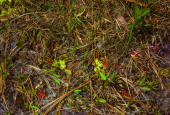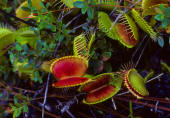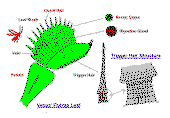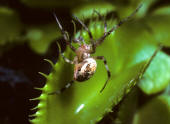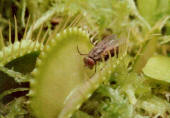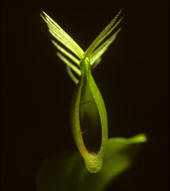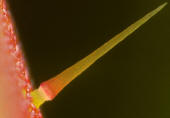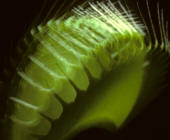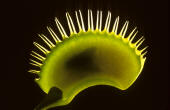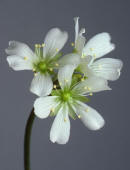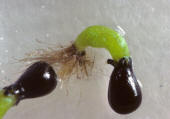|
Carnivorous Plants Story
|
||
|
|
General Probably the best known among all carnivorous
plants because of its swift movement of trap leaves, the Venus flytrap (Dionaea
muscipula) grows in the coastal savannas of North and South Carolina in the
United States.
The plants are federally protected ..????.. The genus name Dionaea is from
Dione, the goddess of
love, in Greek mythology. Venus, in Roman religion, is identified with the
Greek goddess, Aphrodite, whose mother, according to one account, is
Dione.
The genus Dionaea is monotypic; that is, there is only one species, Dionaea muscipula. The genus belongs to the sundew family Droseraceae. Historical Note Description The Venus flytrap uses a snap trap (sometimes
referred to as steel trap), the most advanced trap mechanism to be found
among carnivorous plants.
The trap portion consists of two semicircular lobes united along the midrib of the leaf blade. Around the margin of each lobe grow stiff, spine-like guard hairs (15 to 20 along each margin), which mesh together when the trap closes to prevent the prey's escape. Along the inner edge of each lobe just below these marginal spines runs a narrow band of nectar glands which secrete sugary substance to attract potential prey. Much of the inner lobe below is crowded with numerous digestive glands, which often give the trap surface a bright-red coloration. Each inner lobe surface has three -- sometimes 4 or more -- fine bristles located in a triangular pattern. These are trigger hairs, which are sensitive to physical stimulation and, when properly stimulated, initiate a rapid trap closure. Prey Capture When an unwary insect brushes these hairs,
the trap snaps shut, usually in less than half a second. The guard hairs of each
lobe mesh together to prevent the insect's escape, and the prey is hopelessly
confined between the two lobes. Screening of Prey Typically, insects and
other small bugs -- such
as flies, ants, and spiders -- are known to be prey for the
plants in the wild.
When the plant is in a vigorous growing condition, one often observes a band of
wet surface along the margin of the blades. This is due to secretions from the
nectar glands. With its mouth working on the inner margin of
the lobe where nectar is being served, an insect large enough in size to brush
against some of the trigger hairs ends up tripping the deadly trap. The trigger
hairs are so situated, in relation to the nectar
band, that, given a mature trap of 20-30mm in length, an insect less than
5mm or less is not likely to trigger the trap. Considering the amount of energy
needed for a tiny plant to close the trap, this preliminary screening of prey
large enough to make it worth the effort can be construed as an economic measure
of a sort. Lloyd cites a report showing that, of fifty closed traps examined,
only one contained the catch less than 5mm in length, and only seven less than
6mm in length. All the other catches were 10-30mm in length. There are two phases in the trap closure. The initial phase is characterized by a quite rapid movement of the trap lobes that brings guard hairs on the edge of both lobes together, close enough to interlace them. This will effectively entrap the prey of sufficient size inside the trap, while leaving some open spaces between interlaced guard hairs for small er prey to escape -- the second screening of prey, if you will -- before proceeding to the digestive phase. Multiple Stimulation Requirement It is well known among growers that, in order to close the trap, not one but two stimulations are required: either two different trigger hairs must be each stimulated once, or a single trigger hair stimulated twice. This is the plant's clever way of making sure that the prey about to be snapped has reached the center of the trap before triggering the trap. This delay strategy increases the chance of a successful catch. With each snap consuming so much energy, the Venus flytrap can not afford too many misses. It is also observed that a mild rain usually does not trigger the trap. Many experiments have been
conducted on this snap trap
behavior of the plant. In a normal condition, stimulating a trigger hair once
does not cause a trap movement. To initiate a successful closure, it is
necessary to stimulate two different hairs, or stimulate the same hair twice,
within a 20 seconds or so interval. Studies have shown that sensory cells responsible for triggering the trap are located near the base of the trigger hair, at the indentation where bending strains are most pronounced when hairs are touched. Action potentials have been observed upon bending of the trigger hairs. Closure Mechanism A sudden drop of the cellular pressure on the
inner surface of the lobes causes the imbalance to the higher pressure of cells
on the outer surface, thus precipitating a sudden closing
action of the trap.
The reopening phase, on the other hand, proceeds rather slowly, taking several
hours. Unlike the rapid closing phase, it is due to cell growth. A growth rate of
an activated leaf is higher than an undisturbed trap and a reopened lobe
has been
measured to be several percent
larger than the original size. The trap can be made to close by mechanical stimulation to the trigger hairs. The trap reopens the next day if the trap is empty, or only contains inanimate object with no nutritious value to the plant. Each trap can be "fooled" to close several times before it reaches its growth maturity and ceases to function. Digestion and Absorption The initial phase of rapid closure is
followed by what is termed the narrowing phase. This second phase is pursued
only if the trap catches something nutritious to the plant, or if the stimulus
is continuously coming as would be the case if a live insect is captured. The
narrowing phase is a slower process which brings the margin
of two lobes tightly together.
Often the pressure exerted in this phase is strong enough to crush a soft-bodied
insect prey, thus possibly causing chemical stimulation. As the lobes are tightly sealed, digestive fluids are secreted from the digestive glands into the closed trap interior. The prey, if still alive, will most probably be suffocated in the fluids. The digestive secretions which is known to be initiated only by proper chemical stimulation typically begins a day or so after the capture of prey, although such protein-rich substances as egg-whites may often induce copious secretions in a matter of a few hours. Digested material is then absorbed through the glands and through the inner surface of the trap. The digestive process, not unlike that of an animal's stomach, lasts for a few days to a week, depending on the size of the prey. When the digestion/absorption process is over, the trap (now dry) reopens, revealing the chitinous remains of the prey. The wind and rain clean the lobes, and the trap is ready again for another meal. Each trap is capable of completing the whole digestive process two or three times at most before it ceases to function. Too large a catch often results in the damage of the trap, as the trapped animal begins to decay, causing the entire leaf blade to blacken and die out before the digestion is complete -- an upset stomach, as it were. Inflorescence In the early spring, a flower bud appears in
the rosette center. In a month or so, this develops into a tall scape (flower stem) bearing
many white flowers. A scape often reaches a
height of 20-30cm in nature, providing a possible spatial
separation of pollinators and prey. In nature, the seeds germinate shortly after
the dispersal and tiny seedlings have a few months to prepare for the onset of
winter. In spite of A relatively small size of the plant, It takes 3 to 4
years for the seedling of the Venus flytrap to reach a flowering age.
Birth of flytraps. Two-day^ In May through June, many white flowers bloom at the tip of a tall flower stem rising from the center of the plant. Seeds mature by mid-summer, and tiny Venus flytrap babies are produced. It takes 3-4 years for the seedlings to reach flowering age.
This build-up of a threshold potential before a trap motion is actually triggered is considered advantageous for the Venus flytrap. This ensures a successful catch in many cases, by properly positioning the prey in the center of the trap plate before a trapping attempt, rather than closing the trap prematurely when much of the insect's body may still be outside the trap.
Introduction VenusFlytrap Sundews PitcherPlants CobraPlant Butterworts Bladderworts
|
|
